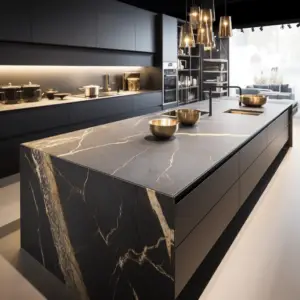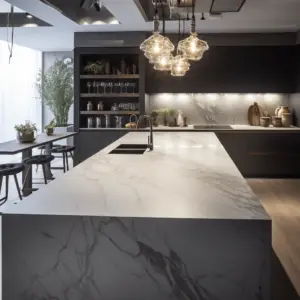Neolith Vs Dekton , are brand names for sintered stone countertops. Sintered stone or ultra-compact surfaces are a fairly new product in the market but very quickly they are gaining popularity for reasons that will be outlined below.
Sintered stone is a high-performance product made from the sintering process with the end product being referred to as a sinter so Neolith and Dekton are both sinters.
Some believe Neolith to be a superior product and a denser countertop and have dubbed Neolith an ultra-compact surface and Dekton a compact surface.
Both brands are the same and varying thicknesses and densities are available for varying market needs so this is not necessarily the case.
Table of Contents
Sintering

Sintering metal, wood, and plastic is an old process but sintering stone is fairly new.
The process imitates the natural process that creates stone where various natural materials are impacted by pressure and heat beneath the ground creating the different kinds of stone that we know such as marble and quartz.
Sintering is artificial but the raw materials are natural and the recipes are proprietary. Portions of different natural materials mostly stone and ceramics are subjected to extremely high temperatures and pressure.
The temperatures are high enough to destabilize the atomic structures of the materials but not to liquify them.
The high pressure impacts these materials causing them to bond mechanically without bonding chemically.
Temperatures can be as high as 2000 degrees Fahrenheit under pressures of nearly 6000 psi ( pounds per square inch )
Upon cooling, the resultant stone is very strong and hard. Below are some of the characteristics of sintered stone.
Neolith Vs Dekton: Properties of Sintered Stone
Sintered stone lacks nearly all of the weaknesses of natural stone and carries all of the advantages.
Durability
Sintered stone is resilient and may only be destroyed by industrial blunt force. The material is dense, making damage difficult.
Marble lasts decades, thus sintered stone can be reused but not replaced.
Scratch and stain-resistant
Sintered stone is too hard to get scratched and can be used for any number of purposes.
Ceramic knives are the exception. Since sinters are made of natural materials, resins are not included which means there is nothing for stains to bond with and create a blotch.
Spills of wine and drinks cannot stain the stone even if left to sit nor will they get absorbed since the stone is non-porous.
Cannot be damaged by UV light
Sintered stone does not fade over time making it a perfect fit for both indoor and outdoor use. While a sealant is a good idea, it is rather unnecessary especially since there is already a design layer that decorates but also protects the stone.
Does not warp or bend.
Sintered stone does not respond to temperature fluctuations making it a suitable product for all types of weather in all regions.
Environmentally safe
Sinters are made of natural materials only. The stone is therefore 100% recyclable or made of pure materials that need to be recycled such as broken ceramics and discarded marble, quartz, and granite.
This makes the countertop one of the best innovations in recent times given the need to come up with materials that serve human function without tearing down the planet.
Food safety
The surfaces are non-porous which means food safety is all but a guarantee. The scratch-resistant non-porous surfaces are not hospitable to bacteria and are also easy to maintain which is an ever-present need in the food and beverage industry.
These surfaces are also resistant to any chemical action which means cleaning them to the point of sterilization will not cause them to discolor or deteriorate in appearance over time.
The medical sector will certainly find these handy soon enough. Chemical laboratories may hop on the wagon as well.
Light in weight
It would be logical to imagine that such densities would produce heavy countertops but they are actually quite light and easy to ferry.
This will reduce the costs associated with transporting them from place to place which is often a concern where stones such as marble are concerned.
Variety of designs
Sintered stone does not have natural grains or patterns which paves the way for design motifs to take many forms.
They can be patterned to mimic perfectly the grains of other stones such as marble or painted to mimic wood. Some can be abstract designs that borrow from any number of sources or simply plain singular colors.
They also come in different finishes such as gloss, flat, and matte so different rooms can be fitted with the appropriately finished countertop.
Disadvantages of Sintered Stone

Is not DIY friendly
You are not likely to be able to work this countertop since its density alone means power tools and expertise is a must-have. Even installing the full piece is a job for a trained fabricator and not a DIY project.
Installation can be difficult
At the moment, the stone has yet to penetrate the market and therefore sufficiently trained installers are few and far between.
Furthermore, owing to their size they can be cumbersome to work with but the real issue is the fact that they cannot be resized during installation which means even a practiced professional requires very precise measurements right at the point of purchase.
Repair work is very expensive
Since sintered stone is difficult and expensive to repair, improper installation could break the stone, making it unusable.
Neolith Vs Dekton: Which is Better
Neolith and Dekton may only differ in terms of sizes, designs, and finishes of the sintered stone that they produce and market but both of these products exhibit the characteristics expounded above.
Since both brands are available and will continue to penetrate the market, be on the lookout for the brand that will give you the precise effect you are looking to create in your business or home.
The best brand is really a matter of preference.


